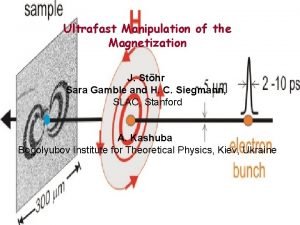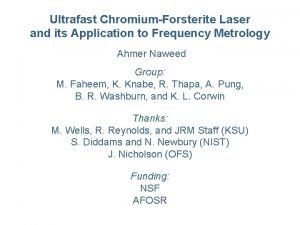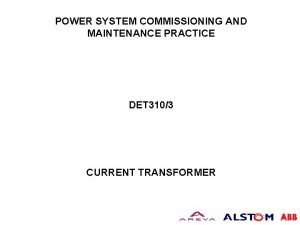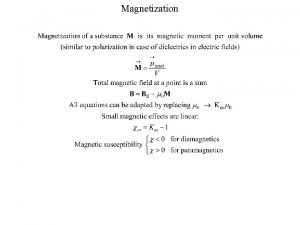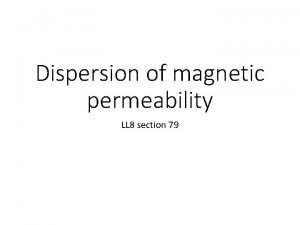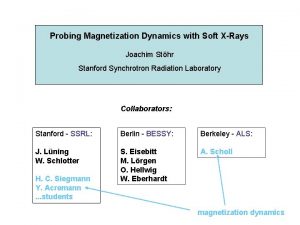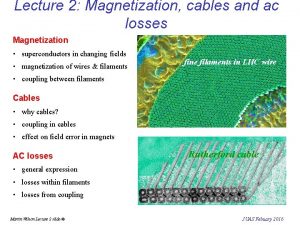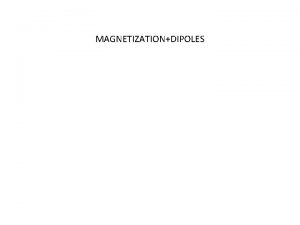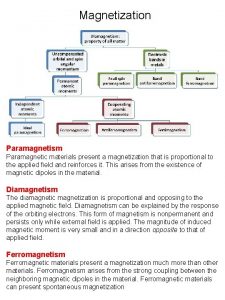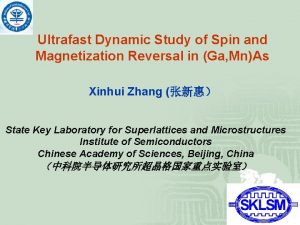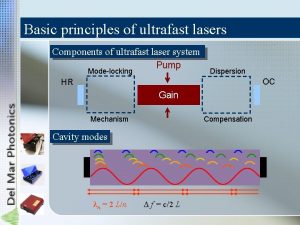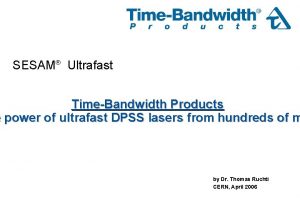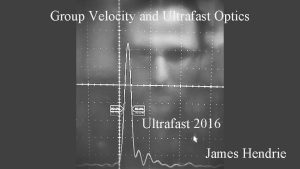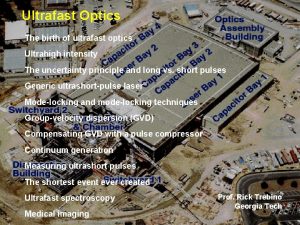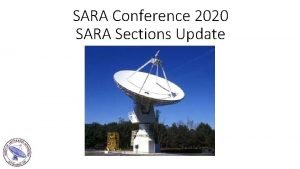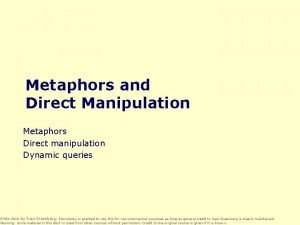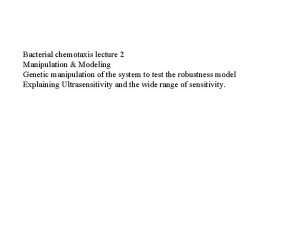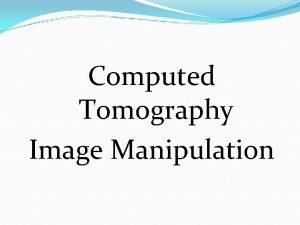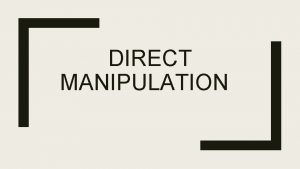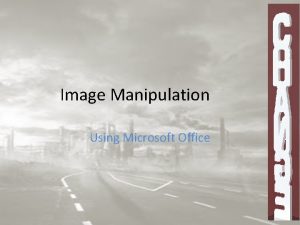Ultrafast Manipulation of the Magnetization J Sthr Sara
























- Slides: 24

Ultrafast Manipulation of the Magnetization J. Stöhr Sara Gamble and H. C. Siegmann, SLAC, Stanford A. Kashuba Bogolyubov Institute for Theoretical Physics, Kiev, Ukraine

Drivers of Modern Magnetism Research: Smaller and Faster The ultrafast technology gap

“for the discovery of giant magnetoresistance” “pinned” “ 0” “ 1” GMR “reads” the magnetization state

from “reading” to “writing” information ? “ 0” “ 1” The big questions: • What are possible switching methods? • What are the physical processes (and intermediate states)? • What limits the speed of switching?

Conceptual methods of magnetization switching Optical pulse Lattice shock t ~ 1 ps electrons move in femtoseconds Electrons Phonons atoms move in picoseconds exchange or spin-orbit ? t ~ 100 ps Spin field pulses or spin currents into magnetic element

Creation of large, ultrafast magnetic fields d o th e m l a n o i t w n o e l v s n o Co - to Use field pulse created by a moving electron bunch

Origin of the fast switching idea… What is the pattern written by a lightning bolt in magnetic rock? 100 k. A in a flash of a few microseconds Magnetization follows the field lines

The world’s biggest lightning bolt Stanford Linear Accelerator Center - SLAC 3 km, 30 Ge. V

Magnetic writing with SLAC Linac beam thin Co film on Si wafer premagnetized 5 ps 1 n. C or 1010 electrons C. H. Back et al. , Science 285, 864 (1999)

In-Plane Magnetization: Pattern development • Magnetic field intensity is large • Precisely known field size no circles around beam ! very different from lightning pattern 540 o Rotation angles: 720 o 180 o 360 o

The pattern written by a picosecond beam field M initial magnetization direction of sample beam damage Max. torque T=Mx. H Min. torque = 0 Fast switching occurs when H ┴ M

Ballistic Switching – From nano to picoseconds Patent issued December 21, 2000: R. Allenspach, Ch. Back and H. C. Siegmann end of field pulse M Relaxation into “down” direction governed by slow spin-lattice relaxation (100 ps) - but process is deterministic ! Precise timing for a=180 o reduces time

Toward femtosecond switching Experiments with sub-ps bunches • reduce bunch length from FWHM t = 5 ps → 140 fs • keep beam energy and charge fixed (~1010 electrons or 1 n. C) • fields B ~ charge / t and E = c B are increased by factor of 35 • our fields have unprecedented strength in materials science: B-field: 60 Tesla E-field: 20 GV/m or 2 V / Angstrom

How does a relativistic e-beam interact with a material ? note E and B fields are defined within and outside e-bunch

Magnetic pattern is severely distorted for short bunch 10 nm Co 70 Fe 30 on Mg. O (110) 140 fs 15 layers Fe on Ga. As (110) 5 ps damaged area

Magnetic pattern is severely distorted --- does not follow circular B-field symmetry Calculation of pattern with Landau-Lifshitz-Gilbert theory known magnetic properties of film, known length, strength, radial dependence of fields B-field only B-field and E-field

Consider effect of giant E-field of beam magnetocrystalline anisotropy caused by anisotropic atomic positions “bonding fields” distort valence charge – static effect Beam field E ~ 1010 V / m = 1 V / Å comparable to “bonding fields” leads to ultrafast distortion of valence charge - all electronic dynamic effect all new “magnetoelectronic anisotropy” – ultrafast !

Magneto-electronic anisotropy is strong ~ E 2 352 or about 1000 times stronger than with previous 5 ps pulses B-field torque E-field torque

Practical Realization of E-field switching • Giant accelerator is impractical • Want to produce pure E-field effect – no B-field effect • Field pulse needs to be fast How about photons ? We know effect is ~E 2 Linear B-field effect cancels over a full cycle

SLAC e-beam pulse corresponds to THz half-cycle pulse 100 fs 10 THz red: SLAC pulse black: THz half cycle pulse true “EM wave”

• Need strong THz radiation - not readily available • Presently only produced by accelerators • Laser generated THz about 100 times weaker at present Can sample handle intense THz pulse ? Heating of sample would be problem….

Compare beam impact region for different pulse lengths same sample: 10 nm Co 70 Fe 30 on Mg. O (110) Magnetic image Topological image by means of SEMPA microscopy Pulse length: 4 ps beam damage Pulse length: 140 fs 35 times shorter pulse & stronger fields cause no heating, no damage !

If there is an E-field - why is there no heating? strong E field should cause current flow - severe Joule heating Potential of a regular linear lattice Co bandwidth DV ~ 3 e. V a Potential along E field direction E ~ 1010 V/m a = 0. 25 nm DV = e E a ~ 2. 5 e. V Offset of “bands” ~ bandwidth potential gradient leads to breakup of conduction path no current flow due to field – no heating

Summary material behave very strange in extreme fields ! • Unusual E and B field effects • No apparent heating or damage by beam • Extreme THz science just starting….
 Ultrafast demagnetization
Ultrafast demagnetization Ultrafast magnetism
Ultrafast magnetism Ultrafast
Ultrafast Ct magnetization curve test
Ct magnetization curve test Magnetization formula
Magnetization formula Magnetic permeability of materials
Magnetic permeability of materials Curl of magnetization
Curl of magnetization Phản ứng thế ankan
Phản ứng thế ankan Chó sói
Chó sói Thiếu nhi thế giới liên hoan
Thiếu nhi thế giới liên hoan Khi nào hổ con có thể sống độc lập
Khi nào hổ con có thể sống độc lập điện thế nghỉ
điện thế nghỉ Một số thể thơ truyền thống
Một số thể thơ truyền thống Trời xanh đây là của chúng ta thể thơ
Trời xanh đây là của chúng ta thể thơ Slidetodoc
Slidetodoc Thế nào là số nguyên tố
Thế nào là số nguyên tố đặc điểm cơ thể của người tối cổ
đặc điểm cơ thể của người tối cổ Tia chieu sa te
Tia chieu sa te Các châu lục và đại dương trên thế giới
Các châu lục và đại dương trên thế giới Thế nào là hệ số cao nhất
Thế nào là hệ số cao nhất Tư thế worm breton là gì
Tư thế worm breton là gì ưu thế lai là gì
ưu thế lai là gì Sơ đồ cơ thể người
Sơ đồ cơ thể người Tư thế ngồi viết
Tư thế ngồi viết Cái miệng bé xinh thế chỉ nói điều hay thôi
Cái miệng bé xinh thế chỉ nói điều hay thôi

